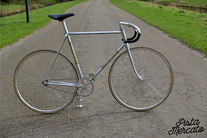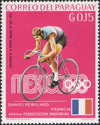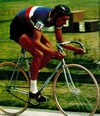A very special one. Old frame from French cyclist Daniel Rebillard. Men's Omnium Individual Pursuit track cycling event during the Mexico 1968 Olympic Games on October 18, 1968 in Mexico City. He won the gold medal Second in the French Championships, he was not to participate in the Games, and he was only selected for the holder at the last moment. However, at 19, this quasi-unknown caused surprise. He climbed to the final, and won it by beating the favorite, Mogens Frey (Denmark), who had broken the world record in the quarterfinals. Daniel Rebillard drew from the bottom of himself and found the resources to resist the return of Mogens Frey in the last kilometer. Daniel Rebillard went professional in 1969, without much success. He ended his career in 1974 at the age of 26. Info about Wolhauser. . The WOLHAUSER cycles have existed since 1945, when the rider of Swiss origin moved to Lyon in his famous store on avenue Berthelot, which saw a multitude of big names in national and Lyon cycling pass by at the time. Runners like Bernard THEVENET, Paul GUTTY, Daniel REBILLARD wore the famous jersey WOLHAUSER cafes Ravis de Gribaldy. . At the beginning Raymond Wolhauser was therefore a RHONSON agent, the law also allowed him to use his name as a trademark. In this case, there was never a typical machine, each of them was assembled "à la carte", according to the customer's choices. From 1946 until 1953, in Saint-Romain-en-Gier, Mario Miosotti (who had learned the trade at LONGONI) brazed frames almost exclusively for WOLHAUSER and more sporadically from 1954 (when he moved to Givors ). Frames were also purchased from FOLLIS, the highest of which (a tandem kept by a museum, a city bicycle and two racing bikes, from collectors, show exceptional refinement) .There were probably other sources and it is possible that frames were modified or repaired in a very small room adjoining the store. In the last 50 years, a close relationship with Giuseppe Martano allowed Wolhauser to buy very beautiful red frames, with the white head tube and a sleeve, from GALMOZZI in Milan. These frames with the perfect finish made it possible to cross an important qualitative stage as well as a little "exoticism" that lovers of beautiful bikes quickly appreciated. They were available in two qualities: COLUMBUS (perhaps the first introduced in France) and "central heating", according to the appreciation of Raymond Wolhauser. . Martano also opened the doors for him to the best Italian accessories manufacturers including CAMPAGNOLO and UNIVERSAL (from whom he already bought a little material via importers) in order to directly obtain more advantageous prices allowing larger supplies, and thus to be able to deal quickly and long to all requests. "Giuseppe Martano (1910-1994) was Amateur World Champion on the road in 1930 and 32, from Italy in 1932, 3rd in the Tour de France 1933 and 2nd in 1934, 2nd in the Giro 1935. In the 1940s, once again an amateur he made some races in France (for the RHONSON team in 1948) that is perhaps why Raymond Wolhauser got to know him. Then he made the rims of the same name. " . The fame of WOLHAUSER still growing when in 1960 (or 61) Raymond Wolhauser managed, again thanks to Martano, to obtain, from the framebuilder Giuseppe PELA in Turin, Team Sports Group CARPANO supplier, the COLUMBUS 6/9 tenths frames, and some in constant 4 tenths, enamelled like those of the "pro" team, metallic gray with white and black rings on the seat tube, chrome-plated Italian style, including aesthetic was very successful * . Some were in metallic yellow instead of gray, others were enamelled in LEGNANO colors. It would seem that the first frames delivered were assembled with the same fittings, with a very modern stripped design at the time, as those intended for the team of the Italian sports group, unless it was only 4 tenths. It is possible that these fittings did not please Raymond Wolhauser and very quickly other more "cut" replaced them. * This decoration was popular and, with a few variants to avoid plagiarism, many frames, of all brands, were enamelled in this metallic gray at DEPIGNY. . When, in 1963, WOLHAUSER began equipping its riders with fully chromed PELA frame bikes, such a machine became essential for those who wanted to ride on the very best. Paul Gutty showed it advantageously in some "pro" races, Charles Rigon smashed the Mont-Faron record (both were amateurs outside the category) , Bernard Thévenet won the Grand Prix of France and was Junior French Champion, then in Mexico, Daniel Rebillard became Olympic Champion in individual pursuit (he had been selected as a replacement for team pursuit) . For his last racing season Henri Anglade used one too. . Giuseppe Pela (18 April 1902 – 31 May 1981 Giuseppe Pela' did not want anyone to know what he built. At one race, Pela and Giuseppe Scapola saw Jacques Anquetil, they said hello to him and Pela' told Giuseppe afterwards that Anquetil's bike had a bottom bracket height 2 cm. higher then normal; so as to pedal through the turns. Asked how he knew, Pela' laughed and said he knew because he built the frame!" Giuseppe Pela' left frame building in the early 1970s to care for his ill wife. He passed away on 31 may 1981 may he rest in peace. One of his son's still was still living at the old address, however he also died recently of a heart attack. All the frame building equipment had been dispersed years ago, possibly to Tomassini, who has readily acknowledged his influence." "Pela' never wanted his own name on any frame, probably to not interfere or conflict with the business interests of the teams and riders he built for." . These chrome frames were no better than those of the same enamelled manufacture, but their appearance brought WOLHAUSER to the culmination of its reputation which will last beyond their availability. Even before the 1968 Olympic Games, rainbow rings appeared to decorate the frames. Then WOLHAUSER abandoned the small historic marks, red and white in decals for stickers with very large white letters not threaded, but also red and some black for clear bikes. After the Olympics he temporarily added the Olympic rings to the enlarged rainbow rings. In 1971, contract frames from the previous season were decomposed and painted with epoxy, only red (according to Henry), for the team runners but sold little. "Wolhau" refused for a long time that the COLUMBUS labels were affixed so that the competitors did not know what metal his bikes were made of. During this whole period, to respond to specific requests, or to reduce the delay, if there was not in stock a PELA frame which corresponded to the need of a client, frames from other sources were punctually used, probably from camera operators in Lyon. It is not possible to know either the number or the origins. For several years the stocks of UNIVERSAL brakes and ZEUS accessories were such that they allowed WOLHAUSER to offer bikes at competitive prices without reducing their appearance or reliability. The price was not the only factor in favor of ZEUS: certainly the crankset shone less than those of other brands but it could receive a small plate of 36 teeth (the CAMPAGNOLO was limited to 42) and this was very useful in the mountains nearby. "Wolhau" considered the ZEUS bottom brackets and wheel hubs to be the most reliable on the market, but the derailleurs required meticulous and sometimes complicated adjustment. And the balance of laces was still not used up. In 1973 "Wolhau" received a MIOSOTIS frame in welded aluminum alloy without connection and polished, manufactured by Mario Miosotti in Givors, around which a bicycle was assembled and marked WOLHAUSER for Cyrille Guimard who used it for Paris-Nice 1974. It seems that this frame did not resist and was returned to the manufacturer who would have then sawed all the tubes to fit them, with gluing in dural fittings that he had made himself. A very small series of these new MIOSOTIS fittings was delivered to Wolhauser, see the assembly details on http://anciensveloslyonnais.weebly.com/miosotis-mario-miosotti.html . The big defect of these frames was the very high price (problem to which Mario Miosotti has, it seems, never found a solution) . Probably in 1974, Raymond Wolhauser obtained the exclusivity of the frames in polished "dural", without connection manufactured by Raymond CLERC in Bron. The maintenance was very restrictive and many were glazed later. Then a colorless transparent varnish kept the beautiful shiny aspect of the polishing, sometimes accompanied by partial enameling. In 1979 Philippe Chevallier became Junior French Champion on the road with a "dural". Bernard Thévenet used one instead of his team's ALAN frame, as did Luis Ocana at the 1977 Tour de France, without showing the brand. A Geneva bicycle dealer, VIFIAN, sold WOLHAUSER "dural" bikes before buying the frames directly from CLERC, to assemble the bikes and sell them to his own brand, just like, from 1975 to 82, in Montluçon, bicycle dealer Jean CALMUS bought steel and dural frames from Wolhauser, CLEMENT tubulars, MARTANO rims and ZEUS equipment. After VITTORIA, "Wolhau" had the exclusivity of CLEMENT casings, sold "dry to point" according to the usual ritual of drying control. Giuseppe PELA had suddenly stopped his activity in 1972, apparently for health reasons. As the stock of steel frames dwindled, Raymond Wolhauser had to source elsewhere. It was first at PICCHIO in Italy but it did not last long (perhaps because PICCHIO signed the frames with the hind legs). For the rest, the frames were delivered "white lime" (in order, eventually, to remove any indication of source) and enamelled in LYON at DEPIGNY. Then by "Pepe" Giuseppe LIMONGI at Rueil-Malmaison, in COLUMBUS frames with Italian dimensions (to perpetuate what had become the qualitative standard of "Wolhau"). . Frames with French dimensions were also made at Ernesto COLNAGO in Italy, to whom "Wolhau" supplied the SUPER-VITUS tubes much cheaper, thanks to the quantity he had bought. In order to obtain these "Wolhau" frames, I also had to buy others marked COLNAGO and, maybe even some complete bikes. These two collaborations came to an end. Some executives always arrived from various other origins whose quality level was very irregular. After this eventful period, gradually, in the second half of the 1970s, more and more executives came from BACO (Batifoulier and Collas) in Romainville, and if this was no longer the very high level of PELA, it guaranteed everything similarly a good constant level. It was Raymond Wolhauser who supplied SUPER-VITUS tubes and BOCAMA fittings (manufactured in Vénissieux). He had bought so much of each that much later they had to be scrapped because they had rusted. Other executives arrived from MURGUE in Saint-Etienne and Jacky BLAIN in Vienna, and perhaps also some in COLUMBUS from BACO. Overall, the steel WOLHAUSER had lost two of the characteristics that had made their reputation: the frames were no longer in COLUMBUS, nor made in Italy. In the 1970s and 1980s WOLHAUSER handlebars, stems and seatposts were manufactured by DURACYCLE in Grigny. The stock of frames and accessories was sometimes sold out long after manufacture. On a recent frame accessories in stock for several years could be fitted, and vice versa. Frames made together could become bikes and be sold several years apart (including, sometimes, with forks from another manufacturer), and a frame that had been sold for ten years could belatedly suit a customer late. All mixtures of accessory brands were possible. At the time, the equipment was evolving only slowly, the runners were very conservative and the customers were not yet aware of the news because there was no specialized press today… And everyone trusted the "Grand Wolhau", an atypical biker, who always favored the general appearance of the bike, the quality of the frame, the bearings and reliability (there was no question of a rider losing a race because a failure of the bicycle) more than the lightness and novelty. Thanks to the flawless assemblies of a loyal mechanic, a flattering presentation of the machines, the numerous victories and perhaps even more to word of mouth from satisfied customers, he had an unrivaled reputation for such a small brand. Whatever the level of range of its equipment, a WOLHAUSER was always admired. WOLHAUSER never made a frame and was therefore not a manufacturer but a manufacturer. Raymond Wolhauser passed away on June 6, 1992. May he rest in peace. At the end of the 1980s, bikes were assembled around VITUS DURALINOX and ALAN frames. We do not know the origins of steel frames after 1990. There were also mountain bike and BMX Wolhauser. . Courtesy of a big part of the info above can be found on: https://raymondwolhauser.weebly.com . . 57cm center center 59cm center top 57cm top tube
Frame:
Columbus
Fork/Headset:
Columbus / Zeus pista
Crankset/Bottom Bracket:
Stronglight / Stronglight
Pedals:
Lyotard pista
Drivetrain/Cog/Chainring/Chain:
47-15 / Campagnolo 15T / Stronglight 47T / DID
Saddle/Seatpost:
Cinelli / Zeus 27.2mm
Front Wheel/Hub/Tire:
Nisi M20 pista / Campagnolo nr pista 32H / A.Dugast silk
Rear Wheel/Hub/Tire:
Nisi M20 pista / Campagnolo nr pista 32H / A.Dugast silk
More Info:
I found a couple of pictures of the trackbike with the original parts list.
And some pictures with Daniel Rebillard riding.
Will replace the parts in the near future.
Aswell as the decals which are not period correct atm.
I have asked a friend to reproduce the period correct decals.
The stoke is high.
.
.
To be continued.
Added by kobe. Last updated almost 6 years ago.
















Thor says:
Great one!
Posted almost 6 years ago